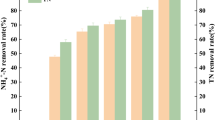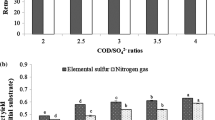Abstract
Wastewater treatment under low dissolved oxygen (DO) conditions is promising for its low energy consumption. However, the removal process of some organic micropollutants, such as triclosan (TCS), could be inhibited under anaerobic conditions. So, it is worth investigating the TCS removal performance at low-oxygen condition. In this study, simultaneous nitrification and denitrification (SND) process, with DO ranging from 0.30 to 0.80 mg L−1, was chosen to investigate. Results showed that the water quality of the effluent was deteriorated after TCS addition at the beginning, with removal efficiency of NH4 +-N dropped from almost 100 ± 0.70 to 88.30 ± 0.98% and COD decreased from 95.15 ± 1.55 to 65.81 ± 2.42 %. However, the performance recovered from the 3rd day and almost stabilized on the 14th day with the removal efficiencies of NH4 +-N were over 98.00 ± 0.60 %, and COD was above 94.00 ± 1.70 % in effluent. Besides, TCS removal efficiencies were more than 93.00 %, and the contributions for TCS removal by the water effluent, sludge sorption, and other effects including biodegradation were 6.46 ± 2.25, 16.27 ± 3.30, and 77.27 ± 4.45 %, respectively. Although the results of absolute abundances of related genes showed no difference (P > 0.05), Illumina MiSeq sequencing analysis presented the variation of microbial community after TCS addition, in which T-45 had the highest Shannon and Simpson diversity index, followed by T-0 and T-2. Relative abundances of alpha and beta-Proteobacteria, which were related to TCS biodegradation, were increased. Compared with Bacteroidetes in T-0, the abundance of Bacteroidetes took up more than 15.6 % in T-45, which should play a more important role under low-oxygen conditions with TCS addition.







Similar content being viewed by others
References
Ansola G, Arroyo P, de Miera LES (2014) Characterisation of the soil bacterial community structure and composition of natural and constructed wetlands. Sci Total Environ 473:63–71
Apha (2005) Standard methods for the examination of water and wastewater. American Public Health Association, American, Washington D.C.
Balmer ME, Poiger T, Droz C, Romanin K, Bergqvist P-A, Müller MD, Buser H-R (2004) Occurrence of methyl triclosan, a transformation product of the bactericide triclosan, in fish from various lakes in Switzerland. Environ Sci Technol 38:390–395
Banihashemi B, Droste RL (2014) Sorption–desorption and biosorption of bisphenol a, triclosan, and 17α-ethinylestradiol to sewage sludge. Sci Total Environ 487:813–821
Bauer M, Kube M, Teeling H, Richter M, Lombardot T, Allers E, Würdemann CA, Quast C, Kuhl H, Knaust F (2006) Whole genome analysis of the marine bacteroidetes ‘Gramella forsetii’reveals adaptations to degradation of polymeric organic matter. Environ Microbiol 8:2201–2213
Bester K (2003) Triclosan in a sewage treatment process—balances and monitoring data. Water Res 37:3891–3896
Bester K (2005) Fate of triclosan and triclosan-methyl in sewage treatment plants and surface waters. Arch Environ Con Tox 49:9–17
Bokare V, Murugesan K, Kim Y-M, Jeon J-R, Kim E-J, Chang YS (2010) Degradation of triclosan by an integrated nano-bio redox process. Bioresour Technol 101:6354–6360
Chalew TE, Halden RU (2009) Environmental exposure of aquatic and terrestrial biota to triclosan and triclocarban1. JAWRA J Am Water Resour As 45:4–13
Chen X, Richard J, Liu Y, Dopp E, Tuerk J, Bester K (2012) Ozonation products of triclosan in advanced wastewater treatment. Water Res 46:2247–2256
Curtis TP (2010) Low-energy wastewater treatment: strategies and technologies. Environ Microbiol, 2nd edn. Wiley, New York, pp 301–318
Drury B, Scott J, Rosi-Marshall EJ, Kelly JJ (2013) Triclosan exposure increases triclosan resistance and influences taxonomic composition of benthic bacterial communities. Environ Sci Technol 47:8923–8930
Fang J-L, Stingley RL, Beland FA, Harrouk W, Lumpkins DL, Howard P (2010) Occurrence, efficacy, metabolism, and toxicity of triclosan. J Environmenta Sci Heal, Part C 28:147–171
Federle TW, Kaiser SK, Nuck BA (2002) Fate and effects of triclosan in activated sludge. Environ Toxicol Chem 21:1330–1337
Good IJ (1953) The population frequencies of species and the estimation of population parameters. Biometrika 40:237–264
Heidler J, Halden RU (2007) Mass balance assessment of triclosan removal during conventional sewage treatment. Chemosphere 66:362–369
Hocaoglu SM, Insel G, Cokgor EU, Orhon D (2011) Effect of low dissolved oxygen on simultaneous nitrification and denitrification in a membrane bioreactor treating black water. Bioresour Technol 102:4333–4340
Holman J, Wareham D (2005) COD, ammonia and dissolved oxygen time profiles in the simultaneous nitrification/denitrification process. Biochem Eng J 22:125–133
Huse SM, Dethlefsen L, Huber JA, Welch DM, Relman DA, Sogin ML (2008) Exploring microbial diversity and taxonomy using SSU rRNA hypervariable tag sequencing. PLoS Genet 4:e1000255
Jia W, Liang S, Zhang J, Ngo HH, Guo W, Yan Y, Zou Y (2013) Nitrous oxide emission in low-oxygen simultaneous nitrification and denitrification process: sources and mechanisms. Bioresour Technol 136:444–451
Kookana R, Ying G, Waller N (2011) Triclosan: its occurrence, fate and effects in the Australian environment. Water Sci Technol 63:598–604
Kwon JW, Xia K (2012) Fate of triclosan and triclocarban in soil columns with and without biosolids surface application. Environ Toxicol Chem 31:262–269
Lee DG, Cho K-C, Chu K-H (2014) Identification of triclosan-degrading bacteria in a triclosan enrichment culture using stable isotope probing. Biodegradation 25:55–65
Lee DG, Chu K-H (2015) Abundances of triclosan-degrading microorganisms in activated sludge systems. Environ Eng Res 20:105–109
Li H, Shen T-T, Wang X-L, Lin K-F, Liu Y-D, Lu S-G, Gu J-D, Wang P, Lu Q, Du X-M (2013) Biodegradation of perchloroethylene and chlorophenol co-contamination and toxic effect on activated sludge performance. Bioresour Technol 137:286–293
Liu Y, Shi H, Xia L, Shi H, Shen T, Wang Z, Wang G, Wang Y (2010) Study of operational conditions of simultaneous nitrification and denitrification in a carrousel oxidation ditch for domestic wastewater treatment. Bioresour Technol 101:901–906
Lozano N, Rice CP, Ramirez M, Torrents A (2013) Fate of triclocarban, triclosan and methyltriclosan during wastewater and biosolids treatment processes. Water Res 47:4519–4527
McAvoy DC, Schatowitz B, Jacob M, Hauk A, Eckhoff WS (2002) Measurement of triclosan in wastewater treatment systems. Environ Toxicol Chem 21:1323–1329
McMurry LM, Oethinger M, Levy SB (1998) Triclosan targets lipid synthesis. Nature 394:531–532
McNamara PJ, LaPara TM, Novak PJ (2014) The impacts of triclosan on anaerobic community structures, function, and antimicrobial resistance. Environ Sci Technol 48:7393–7400
Meade MJ, Waddell RL, Callahan TM (2001) Soil bacteria Pseudomonas putida and Alcaligenes xylosoxidans subsp. denitrificans inactivate triclosan in liquid and solid substrates. FEMS Microbiol Lett 204:45–48
Podosokorskaya OA, Kadnikov VV, Gavrilov SN, Mardanov AV, Merkel AY, Karnachuk OV, Ravin NV, Bonch-Osmolovskaya EA, Kublanov IV (2013) Characterization of Melioribacter roseus gen. nov., sp. nov., a novel facultatively anaerobic thermophilic cellulolytic bacterium from the class Ignavibacteria, and a proposal of a novel bacterial phylum Ignavibacteriae. Environ Microbiol 15:1759–1771
Roh H, Subramanya N, Zhao F, Yu C-P, Sandt J, Chu K-H (2009) Biodegradation potential of wastewater micropollutants by ammonia-oxidizing bacteria. Chemosphere 77:1084–1089
Russell A (2004) Whither triclosan? J Antimicrob Chemother 53:693–695
Singer H, Müller S, Tixier C, Pillonel L (2002) Triclosan: occurrence and fate of a widely used biocide in the aquatic environment: field measurements in wastewater treatment plants, surface waters, and lake sediments. Environ Sci Technol 36:4998–5004
Stasinakis AS, Mamais D, Thomaidis NS, Danika E, Gatidou G, Lekkas TD (2008) Inhibitory effect of triclosan and nonylphenol on respiration rates and ammonia removal in activated sludge systems. Ecotoxicol Environ Saf 70:199–206
Stasinakis AS, Petalas AV, Mamais D, Thomaidis NS, Gatidou G, Lekkas TD (2007) Investigation of triclosan fate and toxicity in continuous-flow activated sludge systems. Chemosphere 68:375–381
Thompson A, Griffin P, Stuetz R, Cartmell E (2005) The fate and removal of triclosan during wastewater treatment. Water Environ Res 77:63–67
Waltman EL, Venables BJ, Waller WT (2006) Triclosan in a North Texas wastewater treatment plant and the influent and effluent of an experimental constructed wetland. Environ Toxicol Chem 25:367–372
Ying G-G, Kookana RS (2007) Triclosan in wastewaters and biosolids from Australian wastewater treatment plants. Environ Int 33:199–205
Ying G-G, Yu X-Y, Kookana RS (2007) Biological degradation of triclocarban and triclosan in a soil under aerobic and anaerobic conditions and comparison with environmental fate modelling. Environ Pollut 150:300–305
Zeng RJ, Lemaire R, Yuan Z, Keller J (2003) Simultaneous nitrification, denitrification, and phosphorus removal in a lab-scale sequencing batch reactor. Biotechnol Bioeng 84:170–178
Zhao C, Xie H, Xu J, Xu X, Zhang J, Hu Z, Liu C, Liang S, Wang Q, Wang J (2015) Bacterial community variation and microbial mechanism of triclosan (TCS) removal by constructed wetlands with different types of plants. Sci Total Environ 505:633–639
Zhou Y, Jiang X (2012) Dissecting android malware: characterization and evolution. 2012 I.E. Symposium on Security and Privacy. doi: 10.1109/SP.2012.16
Acknowledgements
This research was funded by Shandong Provincial Natural Science (ZR2015BM004), the Fundamental Research Funds of Shandong University (2014JC023), the National Science Foundation of China (21007032), and the National Water Special Project (No. 2012ZX07203-004).
Author information
Authors and Affiliations
Corresponding author
Ethics declarations
Conflict of interest
The authors declare that they have no conflict of interest.
Ethical approval
This article does not contain any studies with human participants performed by any of the authors.
Electronic supplementary material
ESM 1
(PDF 184 kb)
Rights and permissions
About this article
Cite this article
Liu, J., Wang, J., Zhao, C. et al. Performance and mechanism of triclosan removal in simultaneous nitrification and denitrification (SND) process under low-oxygen condition. Appl Microbiol Biotechnol 101, 1653–1660 (2017). https://doi.org/10.1007/s00253-016-7952-3
Received:
Revised:
Accepted:
Published:
Issue Date:
DOI: https://doi.org/10.1007/s00253-016-7952-3




